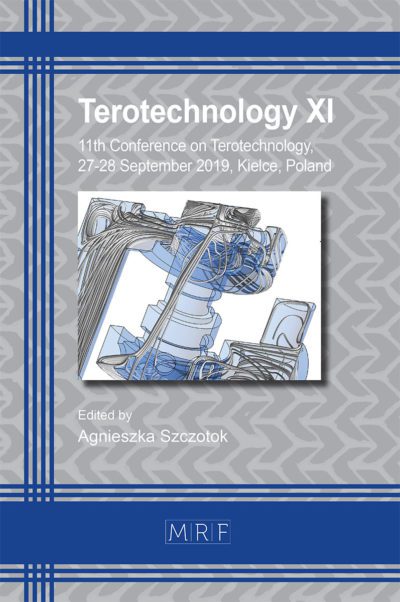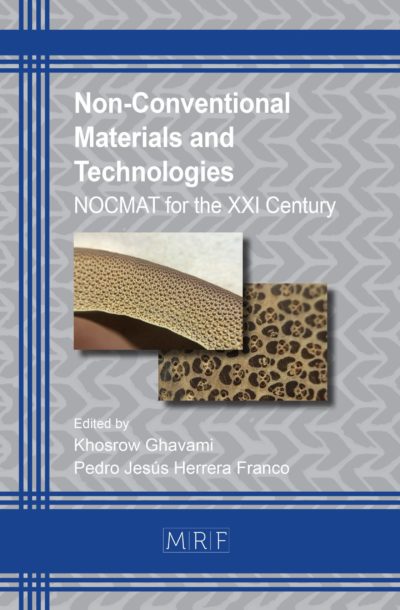Determination of welding parameters for polypropylene rods on a prototype friction welding machine
Sarantis NIKOLETAKIS, George-Christopher VOSNIAKOS, Protesilaos KOSTAZOS
Abstract. A systematic way is presented for determining rotary friction welding (RFW) parameters for polypropylene (PP) rods on a prototype friction welding machine. RFW is a solid-state bonding process, which involves the joining of two components through heat generation, plastification and cooling of the material interface. Due to its high-quality welds, the process has great potential for joining similar as well as dissimilar thermoplastic materials. The key parameters of the process are the rotational speed, pressure and time duration in both friction and forging phases. Improved welding parameters ensure high quality welds with improved mechanical properties. An experimental investigation was carried out to explore the effects of key process parameters on the bonding strength of PP rods, one of the most commonly used thermoplastics. A series of welding experiments were designed and executed using Taguchi’s method (L27). The welded specimens were subsequently tested using a four-point bending apparatus. The flexural strength and overall joint performance were additionally evaluated by Analysis of Variance (ANOVA) method. Some of the main parameters of the process revealed good correlation with the bending strength of the welded specimens.
Keywords
Friction Welding, Polypropylene, Process Parameters, Optimization
Published online 5/7/2025, 10 pages
Copyright © 2025 by the author(s)
Published under license by Materials Research Forum LLC., Millersville PA, USA
Citation: Sarantis NIKOLETAKIS, George-Christopher VOSNIAKOS, Protesilaos KOSTAZOS, Determination of welding parameters for polypropylene rods on a prototype friction welding machine, Materials Research Proceedings, Vol. 54, pp 2371-2380, 2025
DOI: https://doi.org/10.21741/9781644903599-256
The article was published as article 256 of the book Material Forming
![]() Content from this work may be used under the terms of the Creative Commons Attribution 3.0 license. Any further distribution of this work must maintain attribution to the author(s) and the title of the work, journal citation and DOI.
Content from this work may be used under the terms of the Creative Commons Attribution 3.0 license. Any further distribution of this work must maintain attribution to the author(s) and the title of the work, journal citation and DOI.
References
[1] W. Li, A. Vairis, M. Preuss, T. Ma, Linear and rotary friction welding review, International Materials Reviews 61 (2016) 71–100. https://doi.org/10.1080/09506608.2015.1109214
[2] M.B. Uday, M.N. Ahmad Fauzi, H. Zuhailawati, A.B. Ismail, Advances in friction welding process: a review, Science and Technology of Welding and Joining 15 (2010) 534–558. https://doi.org/10.1179/136217110X12785889550064
[3] R. Bayindir, H. Ates, A novel control unit for a friction welding machine based on computer, Materials and Manufacturing Processes 22 (2007) 102–106. https://doi.org/10.1080/10426910601016012
[4] R.J. Crawford, Y. Tam, Friction welding of plastics, J Mater Sci 16 (1981) 3275–3282. https://doi.org/10.1007/BF00586287
[5] M. Sahin, Joining with friction welding of high-speed steel and medium-carbon steel, J Mater Process Technol 168 (2005) 202–210. https://doi.org/10.1016/j.jmatprotec.2004.11.015
[6] G.-C. Vosniakos, S. Karavolos, E. Tzimas, N. Begiazis, A. Kleftogiannis, P. Galanos, M. Chodnicki, E. Pierron, Development of a Friction Welding System for CNC Lathes, in: Y.-C. Wang, S.H. Chan, Z.-H. Wang (Eds.), International Conference on Flexible Automation and Intelligent Manufacturing (FAIM2024), Springer, Lecture Notes in Mechanical Engineering, Taichung, Taiwan, 2024: pp. 40–47. https://doi.org/10.1007/978-3-031-74485-3_5
[7] A. Łukaszewicz, Nonlinear numerical model of friction heating during rotary friction welding, Journal of Friction and Wear 39 (2018) 476–482. https://doi.org/10.3103/S1068366618060089
[8] C.-C. Kuo, A. Farooqui, N. Gurumurthy, S.-H. Huang, Effects of rotational speed on the microstructure and mechanical properties of continuous drive friction welding of dissimilar composite polymer rods, The International Journal of Advanced Manufacturing Technology 134 (2024) 2547–2561. https://doi.org/10.1007/s00170-024-14261-9
[9] F. Lambiase, V. Grossi, S.I. Scipioni, A. Paoletti, Prediction of the power supplied in friction-based joining process of metal-polymer hybrids through machine learning, J Manuf Process 68 (2021) 750–760. https://doi.org/10.1016/j.jmapro.2021.06.001
[10] H.A. Maddah, Polypropylene as a promising plastic: A review, Am. J. Polym. Sci 6 (2016) 1–11. https://doi.org/10.5923/j.ajps.20160601.01
[11] M.W. Hisam, A.A. Dar, M.O. Elrasheed, M.S. Khan, R. Gera, I. Azad, The Versatility of the Taguchi Method: Optimizing Experiments Across Diverse Disciplines, Journal of Statistical Theory and Applications (2024) 1–25. https://doi.org/10.1007/s44199-024-00093-9
[12] R. Singh, R. Kumar, L. Feo, F. Fraternali, Friction welding of dissimilar plastic/polymer materials with metal powder reinforcement for engineering applications, Compos B Eng 101 (2016) 77–86. https://doi.org/10.1016/j.compositesb.2016.06.082
[13] C.-C. Kuo, H.-W. Chen, S.-H. Huang, Rotary Friction Welding of Dissimilar Polymer Rods Containing Metal Powder, Polymers (Basel) 15 (2023) 4354. https://doi.org/10.3390/polym15224354













